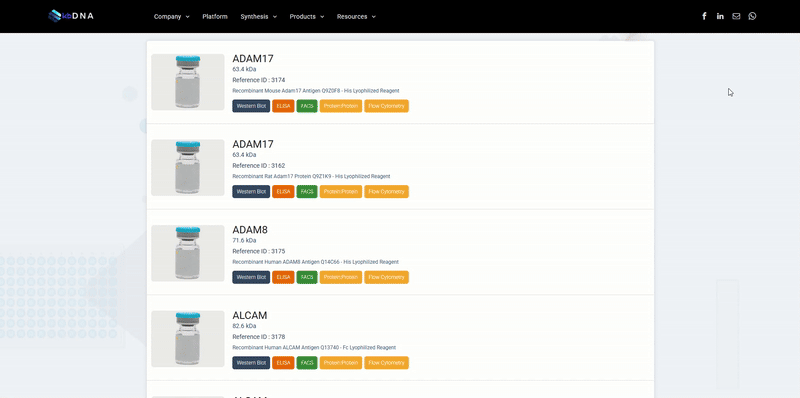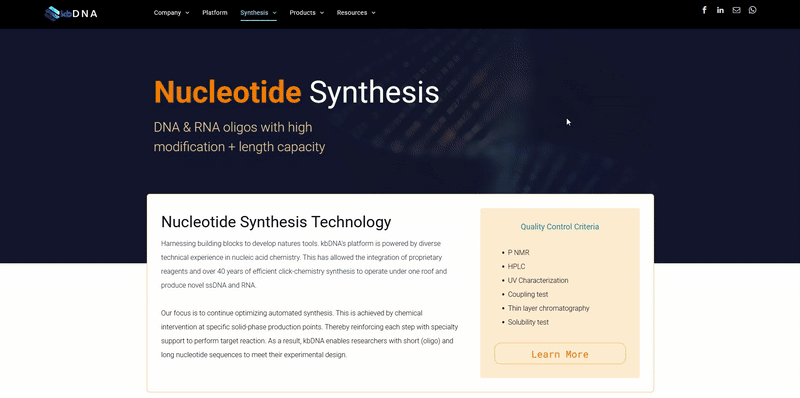Reagent Guidelines
Storage & Prep

Quick Jump To:
Quick Jump To:

Protein Reagents
Reconstitution Protocol
Protein Reagents
- THE FIRST step before reconstitution is to pellet down the contents at the bottom at 12000-13,000 rpm for 30-60 sec
- Dissolve the lyophilized protein in appropriate solvent (sterile distilled water/buffer) to achieve a desired concentration.
- Proper reconstitution of protein is carried out following the reconstitution protocol provided in the certificate of analysis (CoA)
- Briefly vortex and recap the vial after dissolution to make sure even distribution of liquid
- Spin down the vial for few seconds after vortexing
Important Notes
Protein Reagents
- Avoid vigorous shaking or stirring
- Reconstituted vials should be kept at appropriate temperature as per provided CoA
- Appropriate buffer should be used for different proteins. For ex., acidic peptides in basic buffer and basic peptides in acidic buffer
- Additives to enhance shelf life should be added as per provided CoA
Short Term Storage
Protein Reagents
Instructions
- 2°C - 8°C
- <1 Week
Important Notes
- This reconstituted protein solution should not be re-frozen and reused.
Long Term Storage
Protein Reagents
Instructions
- -20°C or -80°C
- 12 Week
Important Notes
- Dilute the reconstituted protein solution using buffer/ media/carrier protein solution
- Reconstituted small working aliquots can be stored in 25-50% glycerol or ethylene glycol at -20 °C or -80 °C to maximize stability and minimize protein denaturation
- Reconstituted protein can be stored frozen for up to 1 year.
- Avoid multiple freeze/thaw cycles.
- Aliquots volume should not be less than 10 µL
- Aliquots concentration should not be less than 1 µg/mL
- Carrier protein should be either 0.1% BSA, 10% FBS, or 5% HAS
- Do not add sodium azide to antibodies to be utilized to stain live cells, or any primary amine coupling reaction.
- All conjugated antibodies should be covered with a light-protecting material (i.e., aluminium foil) or stored in light-protected vials to maintain the activity.

Oligo Reagents
Reconstitution Protocol
Oligo Reagents
- THE FIRST step before reconstitution is to pellet down the contents at the bottom at 12000-13,000 rpm for 30-60 sec
- Resuspend the lyophilized oligo product in appropriate buffer solution (For ex., TE buffer containing 10 mM Tris and 0.1 mM EDTA; pH 8) to achieve a stock concentration of ≥10 µM (ideally 100 µM) as per provided CoA.
- Dissolved oligos are allowed to rehydrate at room temperature for few minutes followed by vortex for 15 seconds
Important Notes
Oligo Reagents
- Avoid light exposure to prevent photobleaching. Avoid vigorous vortexing or stirring
- Nuclease free water can be also utilized for reconstitution.
- pH of reconstituted solution should be neutral or of low alkalinity (pH 7-9)
- If oligos are not easily resuspended, try healing at 55 °C for 1-5 minutes.
- Avoid making working stock solution less than 1 µM.
- Use working solutions as soon as possible to avoid minimize light exposure and temperature fluctuations
Short Term Storage
Oligo Reagents
Instructions
- 4°C
- 12 Months
Important Notes
- This reconstituted oligo solution should not be re-frozen and reused.
Long Term Storage
Oligo Reagents
Instructions
- -20°C or -80°C
- 24-30 Months
Important Notes
- Prepare multiple aliquots of stock solution of oligos by diluting using TE buffer or nuclease free water.
- Reconstituted single use working aliquots can be stored at -20 °C or -80 °C in dark to minimize degradation
- Reconstituted oligos can be stored frozen for up to 24-30 months (>2 years).
- Avoid multiple freeze/thaw cycles.
- Avoid exposure to ambient and UV light to prevent photobleaching
- Dilution factor should be kept low in case of fluorescently tagged oligos
- Store in polypropylene types instead of polystyrene tubes to avoid absorption by tube walls.
Protein Reagents

Reconstitution Protocol
Proteins
-
Centrifuge
THE FIRST step before reconstitution is to pellet down the contents at the bottom.
Centrifuge at:
12000-13,000 rpm for 30-60 sec
-
Protein Reagents
- Dissolve the lyophilized protein in appropriate solvent (sterile distilled water/buffer) to achieve a desired concentration.
- Proper reconstitution of protein is carried out following the reconstitution protocol provided in the certificate of analysis (CoA)
- Briefly vortex and recap the vial after dissolution to make sure even distribution of liquid
- Spin down the vial for few seconds after vortexing
-
Important Notes
- Avoid vigorous shaking or stirring
- Reconstituted vials should be kept at appropriate temperature as per provided CoA
- Appropriate buffer should be used for different proteins. For ex., acidic peptides in basic buffer and basic peptides in acidic buffer
- Additives to enhance shelf life should be added as per provided CoA
Storage Instructions
Proteins
-
Short Term Storage
Short Term
- 2°C - 8°C
- <1 Week
-
Short Term Notes
This reconstituted protein solution should not be re-frozen and reused.
-
Long Term Storage
Long Term
- -20°C or -80°C
- 12 Months
-
Long Term Notes
- Dilute the reconstituted protein solution using buffer/ media/carrier protein solution
- Reconstituted small working aliquots can be stored in 25-50% glycerol or ethylene glycol at -20 °C or -80 °C to maximize stability and minimize protein denaturation
- Reconstituted protein can be stored frozen for up to 1 year.
- Avoid multiple freeze/thaw cycles.
- Aliquots volume should not be less than 10 µL
- Aliquots concentration should not be less than 1 µg/mL
- Carrier protein should be either 0.1% BSA, 10% FBS, or 5% HAS
- Do not add sodium azide to antibodies to be utilized to stain live cells, or any primary amine coupling reaction.
- All conjugated antibodies should be covered with a light-protecting material (i.e., aluminium foil) or stored in light-protected vials to maintain the activity.
Oligo Reagents

Reconstitution Protocol
Oligonucleotides
-
Centrifuge
THE FIRST step before reconstitution is to pellet down the contents at the bottom.
Centrifuge at:
12000-13,000 rpm for 30-60 sec
-
Oligo Reagents
- Resuspend the lyophilized oligo product in appropriate buffer solution (For ex., TE buffer containing 10 mM Tris and 0.1 mM EDTA; pH 8) to achieve a stock concentration of ≥10 µM (ideally 100 µM) as per provided CoA.
- Dissolved oligos are allowed to rehydrate at room temperature for few minutes followed by vortex for 15 seconds
-
Important Notes
- Avoid light exposure to prevent photobleaching. Avoid vigorous vortexing or stirring
- Nuclease free water can be also utilized for reconstitution.
- pH of reconstituted solution should be neutral or of low alkalinity (pH 7-9)
- If oligos are not easily resuspended, try healing at 55 °C for 1-5 minutes.
- Avoid making working stock solution less than 1 µM.
- Use working solutions as soon as possible to avoid minimize light exposure and temperature fluctuations
Storage Instructions
Oligonucleotides
-
Short Term Storage
Short Term
- 4°C
- 12 Months
-
Short Term Notes
This reconstituted oligo solution should not be re-frozen and reused.
-
Long Term Storage
Long Term
- -20°C or -80°C
- 24-30 Months
-
Long Term Notes
- Prepare multiple aliquots of stock solution of oligos by diluting using TE buffer or nuclease free water.
- Reconstituted single use working aliquots can be stored at -20 °C or -80 °C in dark to minimize degradation
- Reconstituted oligos can be stored frozen for up to 24-30 months (>2 years).
- Avoid multiple freeze/thaw cycles.
- Avoid exposure to ambient and UV light to prevent photobleaching
- Dilution factor should be kept low in case of fluorescently tagged oligos
- Store in polypropylene types instead of polystyrene tubes to avoid absorption by tube walls.
If you're interested in our recombinant proteins, our oligonucleotide synthesis services, or anything else, don't hesitate to reach out to us! Feel free to give us a call or submit the form below.
Contact kbDNA
Contact Us
Thank you for contacting us.
We will get back to you as soon as possible.
We will get back to you as soon as possible.
Oops, there was an error sending your message.
Please try again later.
Please try again later.












